Searching for Shangri La - In the autumn of 2019, drive to Gannan, Western Sichuan, Northwest Yunnan (10) Wujiang Gallery, Gongtan Ancient Town.
In 1933, James Hilton's novel "The Vanishing Horizon" depicted a secluded paradise on earth called "Shangri La". In order to find this "ideal home" in people's minds, countless explorers, scholars, and even photographers and backpackers have traveled through Gansu, Qinghai, Sichuan, Yunnan, and Tibet, but ultimately cannot determine where the "Shangri La" in the novel is. More than 80 years have passed, and people are still searching and asking, where is this' last pure land on earth '? Does it really exist?
I think "Shangri La" should have its place, which is far from the imagination of the author. However, the scene in the novel is not exactly the same as the reality. There must be some elements of artistic processing. If you completely follow the description in the novel, you will never find the same "Shangri La" as in the novel. Nowadays, most people generally believe that "Shangri La" refers to the border area between Sichuan, Tibet, and Yunnan, namely the Daocheng Yading area in Sichuan and the Shangri La area in Diqing, Yunnan. In fact, the true location of 'Shangri La' no longer holds much significance. 'Shangri La' has become more of a symbol, expressing people's longing for an 'ideal world', and thus deeply imprinted in people's hearts. Everyone has their own 'Shangri La', and searching for 'Shangri La' means searching for the 'Shangri La' in everyone's heart and the 'Pure Land on Earth' in everyone's spirit.
Along the southern part of Gansu, western Sichuan, and northwestern Yunnan, there are majestic plateaus and towering snow capped mountains; Vast grasslands and magnificent forests; Lakes are like jade, rivers are like silver belts; The temple is mysterious and solemn, with kind and honest folk customs. All of these are very relevant to the description of "Shangri La" in the novel, and walking this line is the best choice to find "Shangri La".
Due to its location on a plateau, many fault zones have formed along the Gannan, western Sichuan, and northwestern Yunnan lines due to crustal movements and the impact of plate compression and collision, resulting in frequent geological disasters such as earthquakes, landslides, and mudslides. Especially during the rainy season, it is not uncommon for roads to be washed away, landslides to occur, and rocks to fall. 9、 October has passed the rainy season and the risk of geological disasters is relatively low, making it the safest time to travel to this area. Meanwhile, autumn is the most beautiful season in this region, with clear clouds and clear skies.
On September 24, 2019, my partner and I embarked on a self driving trip from Beijing to Gannan, Western Sichuan, and Northwest Yunnan.
hot tip
Regarding altitude sickness:
The average altitude of Gannan, Western Sichuan, and Northwest Yunnan is about 3500 meters, and preventing and responding to altitude sickness has become the most critical factor in whether the entire journey can be sustained.
High altitude sickness is actually hypoxia, because the air in high-altitude areas is relatively thin, and everyone will experience high altitude sickness when they first arrive at the plateau. However, some people have mild reactions, while others have strong reactions. Generally, after a day or half a day, most people will adapt. Some people with strong reactions may not be able to adapt, and in severe cases, they must seek medical attention or immediately evacuate to low altitude areas.
I have had a previous experience of excessive reaction. The first time was in 2015 at Xinduqiao, and my reaction was not strong. I woke up after sleeping for a night and it improved. I haven't had it again since then. The second time, in 2016, in Hongyuan, the altitude was not very high, only about 3500 meters, but the reaction was very strong, with a splitting headache that made it impossible to lie down, let alone sleep. Oxygen therapy and medication were completely ineffective, and in the end, I couldn't bear to check out at night and drove back to Chengdu.
Having learned from the previous lesson, I actually have a fear of the plateau in my heart. Although I have always yearned for this route, it has been delayed due to my fear of the altitude sickness. Being able to muster up courage again this time is actually a challenge. Although I have made sufficient preparations in the early stage, I am still not sure if I can pass this level. Anyway, I am prepared to return at any time. In fact, throughout our entire trip, we hardly experienced any strong symptoms of hyperalgesia, which is directly related to our thorough preparation.
Our preparation work includes drinking Rhodiola rosea every day two weeks before the trip, while strengthening physical fitness training to avoid catching a cold. In addition, prepare temporary medications such as Gaoyuan An, glucose solution, and Danshen Dripping Pills to cope with high altitude sickness. Also, I purchased 30 1000mi portable oxygen tanks.
During this trip, there were no strong symptoms of hyperalgesia, and the entire process was successfully completed. In summary, there are several tips for dealing with hyperalgesia, which I would like to share with you. (1) Drinking Rhodiola rosea in advance is effective, preferably starting half a month before travel. (2) Glucose solution has a significant effect on acute symptoms of hyperalgesia. (3) When feeling uncomfortable or experiencing symptoms of hypoxia such as chest tightness, shortness of breath, and difficulty breathing, oxygen therapy can be administered at any time, which is very helpful in relieving hyperalgesia symptoms. (4) Pay attention to keeping warm, wear more clothes as much as possible, do not catch a cold, and do not take a shower. Especially in accommodation, it is best to have heating to provide oxygen therapy. (5) Avoid vigorous exercise, maintain a calm mindset, speak less, drink more water, and avoid overeating. (6) Psychological strength is necessary, and high altitude sickness is a normal physical response. As long as one is well prepared and responds appropriately, there is no need to be afraid. Of course, if the reaction is strong and cannot be relieved, one must seek medical attention promptly.
Regarding road conditions and safe driving:
The condition of this route can be said to be very good, much stronger than in previous years, and there is no problem for small cars to run. There are still two sections of road that need to be cautious. One is the S313 section from Langmu Temple to Diebu County, which has poor road conditions due to road construction. One section is from Shangri La Town to Benzilan Town, and attention should be paid to falling rocks on the mountain.
There is no problem refueling along the way. It is recommended to choose a regular gas station in the county or a larger town, and ensure that the fuel level is not less than one-third of the fuel tank at all times. It should be noted that in many areas of Tibet, when refueling, one must verify their ID card, driving license, and register their vehicle information.
Cars also have a reaction to high altitude, and the most obvious manifestation on straight streets is a decrease in power. If the load is large, the symptoms will be more obvious. It is important to have a full understanding of this while driving.
The topic of safe driving has been mentioned many times in previous travelogues. In addition to conducting inspections and maintenance in advance, preparing reflective fault signs, fire extinguishers, flashlights, spare keys, and simple tools, the most crucial point is to strictly abide by traffic regulations, which is the guarantee of safe driving. There are several reminders to pay special attention to when driving in high-altitude mountainous areas. Firstly, overtaking is absolutely prohibited on bends. Secondly, you must not get too close to the following car, nor should you let the following car get too close to you, especially on uphill or downhill roads, or overtake on horseback, or pull over to let the following car overtake you. Otherwise, slow down or speed up to widen the distance. Thirdly, it is necessary to control the speed of the vehicle and yield to the livestock. If you collide with Tibetan cattle and sheep, even if your vehicle is in good condition, it will still be difficult to compensate.
trip
Day1 (2019, 9, 24): Departing from Fangshan Yidu in Beijing on July 26 (odometer reset). On 10.58, arrive at Xuankong Temple in Hunyuan County, Shanxi Province (odometer shows 241 kilometers). 12.45, heading to Yingxian Wooden Pagoda, having lunch on the way, 14:00, arriving at Yingxian Wooden Pagoda (298 kilometers). On May 24th, head towards the city center of Datong. On June 23rd, arrive at Datong and check into Yungang Jianguo Hotel (372 kilometers away). 18.30, Northern Wei family banquet, dinner.
Day2
(2019, 9, 25): 10.10-13.15, Datong Park, Yungang Grottoes. 13.30, Fenglin Pavilion, lunch. From 14.50-16.00, at Huayan Temple and Jiulongbi.
Day3
(2019, 9, 26): On July 18th, depart for Hukou Waterfall on the Yellow River in Shaanxi Province (odometer shows 414 kilometers), 15.07, arrive at Hukou Waterfall Scenic Area on the Yellow River in Shaanxi Province, and stay at Yunshang Guanpu Fang Hotel (1067 kilometers). At 18.20, dinner will be served in the hotel.
Day4
(2019, 9, 27): 6.50-8.30, Hukou Waterfall. On September 20th, depart for the Liupanshan Red Army Long March Scenic Area in Guyuan, Ningxia. On December 16th, arrive at the Liupanshan Red Army Long March Scenic Area (1620 kilometers). On July 20th, arrive at Longde County, Ningxia, and stay at the Longcheng Hotel (1630 kilometers). 18.10, Old Town Warm Pot, for dinner.
Day5
(2019, 9, 28): Starting at 7.58, heading towards Labrang Temple in Xiahe County, Gansu Province, at 13.40, arriving at Xiahe Jinlun Hotel (2104 kilometers). 15.15-18.20, Labrang Monastery. At 18.40, dinner will be served at the Nobiseo restaurant on the first floor of the hotel.
Day6
(2019, 9, 29): 8.50-10.10, Zhanfo Terrace, Da Jin Pagoda. From 10.25 to 11.27, mulberry wetlands and mulberry grasslands (2114 kilometers). On November 32, heading towards the direction of cooperation, visit Luqu County, Dai'erzong Bridge, Watershed Observation Deck, Gahai Lake, and Treasure Mountain Observation Deck. On April 46, enter the Sichuan provincial border. On August 58, arrive at Langmu Temple Town and stay at Langmu Inn in Luqu Secret Realm (2301 kilometers).
Day7
(2019, 9, 30): 8.28-10.30, Geldi Temple, Namo Canyon. 10.45, heading to Diebu County, 12.55, arriving at Zagana Scenic Area, 13.49, checking into Zagana Original Ecological Hotel (2397 kilometers). From 14.50 to 18.45, Zhagana Scenic Area, Yeri Village, Dari Village, and Daiba Village (2408 kilometers).
Day8
(2019,10,1): August 20th, heading towards Ruoergai Flower Lake Scenic Area, 11.36-14.40, Flower Lake Scenic Area (2526 kilometers). 14.48, heading towards Tangke Town, 16.20, arrive at Tangke Town, and check into Tangke Wangfu Hotel (2631 kilometers).
Day9
(2019, 10, 2): 5:30-8.40, the first bend of the Yellow River. 9.30-16.20, hotel rest. From 17:00 to 19:20, the first bend of the Yellow River. 20.00, hotel dinner.
Day10
(2019, 10, 3): From 9.13 to 12.18, Tangke Town (2688 kilometers), Jiuhong Grassland Scenic Road, Vachetalin, Moon Bay, Hongyuan County Home Hotel (2775 kilometers). From 16.20 to 19.45, dinner for liver in Hongyuan County and Xiaojun.
Day11
(2019, 10, 4): 9, 25, -15.50, Jiuhong Grassland Scenic Road, Chazhen Liangzi Yangtze River and Yellow River Watershed, Yeyaotang Flower Sea, Brushing Temple Town, Zhuokeji Tusi Official Village, Marcang Jiarong Hotel (2961 kilometers).
Day12
(2019, 10, 5): 9.13-14.17, Songgang Watchtower Group, Dajinchuan River, Arico Grassland, Changdu Temple, Dadu River, Jinchuan County, Jiaju Zangzhai Parking Lot (3142 kilometers). From 14.25 to 16.00, Jiaju Tibetan Village. At 16.56, check into the Zangxiangge Hotel in Danba County (3164 kilometers).
Day13
(2019, 10, 6): 8.45-13.05, China Panda Avenue, Yala Snow Mountain, Kangba Eye Observation Deck, Shanka Temple, Bamei Town (3251 kilometers). 13.35-15.20, Moshi Park, Tagong Grassland, Muya Jinta, Tagong Grassland Mandela Hotel (3278 kilometers). 18.10, hotel dinner.
Day14 (2019, 10, 7): 9:38-14.25, Tagong Temple, Xinduqiao Photography Corridor, Xinduqiao Town, Xinduqiao Zangdi Xiangxue Hotel (3333 kilometers). From 17.18 to 19.20, Gongga Snow Mountain Observation Deck. 19.50, hotel dinner.
Day15
(2019, 10, 8): 6.40-8.00, Xinduqiao Town. From 9.50 to 19.20, at Gao'er Temple Pass, Karunbu Village, Yajiang County, Hekou Town, Xianggezong Observation Deck, Jianziwan Mountain Tunnel, Xiongzongka Observation Deck, Nimagung Divine Mountain Observation Deck, Kazila Mountain, Kela Township, Litang County (lunch), Zhaga Snow Mountain, Wuliang River Observation Deck, Tuer Mountain, Haizi Mountain, Shihe Park, Gachong Divine Mountain, Bangpu Temple, Sangdui Town, Hongcaodi, Daocheng White Pagoda, Jinzhu Town (Daocheng County), Daocheng Sunshine Hot Spring Hotel (3712 kilometers). 20.20, hotel dinner.
Day16 (2019, 10, 9): 8.00-10.00, Daocheng County. From 10.00 to 13.00, by the river and at Xiongdeng Temple. From 13:30 to 16.40, Duogelangzhu, Zunsheng Tallinn, Oluo Village, Reu Temple, Bogongshan, Chitu River Valley, Gonggalangjiha Temple, Zhongdui Village, Shangri La Town, Gongjinlian Ri Hotel (3826 kilometers). 18.20-20.30, Shangri La Town, dinner.
Day17
(2019, 10, 10): 7.30-18.45, Aden Scenic Area. From 18.55 to 20.00, dinner at Shangri La Town and Laozhuang Mushroom King Soup Pot.
Day18
(2019, 10, 11): From 9.06 to 16.13, in Mula Township and Zang Township, Qiuse (Peninsula Village), Rivervalley Ranch Observation Deck, Rizhao Shenshan Observation Deck, Dalanggu Ranch Observation Deck, Colorful Forest Observation Deck, Dongwang River, Sedang Village, Se Chong Bridge, Maowu Tunnel, Dingqu River, Derong Dawang Hotel (4070 kilometers). 17,40-19.10, Derong County, dinner.
Day19 (2019, 10, 12): 8.50-12.20, Dingqu River, Jinsha River, Benzilan Town, Jinsha River Big Bend Scenic Area (4175 kilometers). From 12.27 to 15.46, Dongzhulin Temple, Wunong Peak Observation Deck, Feilai Temple Observation Deck, and Meili Past Guesthouse (4270 kilometers).
Day20
(2019, 10, 13): 6:30-8.20, Feilai Temple Observation Deck, Rizhao Jinshan. From 10.20 to 18.50, the No.1 tunnel of Baima Snow Mountain and the Balagezong Scenic Area (Shangri La Grand Canyon) (4400 kilometers). 19.00-20.30, Dukezong Ancient City Manxin Boutique Inn (4481 kilometers). 21.00-22.30, Dukezong Ancient City, Qingmu Kitchen, dinner.
Day21
(2019, 10, 14): 8.11-9.50, Baiji Temple. 10.00-10.50, Dukezong Ancient City. From 12.15 to 16.40, Haba Snow Mountain Observation Deck and Tiger Leaping Gorge Scenic Area (4598 kilometers). From 16.45 to 19.00, arrive at Shuanglang and check into Ideal Life Inn (4768 kilometers). From 19.26 to 21.06, Double Corridor and Southern Courtyard, dinner.
Day22
(2019, 10, 15): 7.20-12.00, double corridor. Depart for Qujing on 12.05, arrive at Qujing on 17.16, and check into Qujing Official Hotel (5260 kilometers). 17,45, Yunnan family, dinner.
Day23
(2019,10,16): 8,45-10.00, Shengjingguan, the hometown of ancient ginkgo trees in the world (Panzhou). 10.00-15.30, Huangguoshu Tunnel, Guiyang West, Guizhou Tianyi Haosheng Hotel (5642 kilometers). From 18:00 to 19:30, Qianling Mountain Park. 20.00, Gualufan, dinner.
Day24
(2019, 10, 17): 6:30-12.48, Nanmudu Wujiang Bridge, Zunyi County, Meitan County, Wulong County, Pengshui County, Wujiang Gallery Scenic Area (6157 kilometers), 13.00-15.00, Wujiang Gallery. From 15:08 to 16.18, arrive at Gongtan Ancient Town and check into Qianshan Inn (6201 kilometers). From 17:00 to 20.00, Gongtan Ancient Town.
Day25
(2019, 10, 18): 6, 50-8, Gongtan Ancient Town, 8.50-11.00, the confluence of Wujiang River and Apeng River, the millennium ancient golden nanmu group (6224 kilometers). 11.20-19.30, Baomao Expressway, Shanghai Chongqing Expressway, Fuchang Yangtze River Highway Bridge, Jingzhou Cloud Hotel (6810 kilometers).
Day26
(2019, 10, 19): 8.48-14.40, Second Guangzhou Expressway, Hanjiang River, Liujiang Yellow River Bridge, Xinxiang Hetang Moonlight Hotel (7406 kilometers). 18.40, Sichuan style Yuqu Ge style braised lamb, dinner.
Day27
(2019, 10, 20): 8.55-14.39, Xinxiang, Henan Hebei border, Zhanghe Grand Bridge, Hebei Beijing border, Zhangfang, Fangshan Yidu (7986 kilometers).
Route

Beijing Fangshan Ferry - Shanxi Hunyuan Hanging Temple - Yingxian Shakyamuni Pagoda - Datong - Yungang Grottoes - Shaanxi Jixian Yellow River Hukou Waterfall - Ningxia Guyuan Liupanshan Red Army Long March Scenic Area - Longde County - Gansu Xiahe County Labrang Temple - Sangke Grassland - Gahai Lake - Sichuan Langmu Temple Town - Gannan Diebu County Zagana - Sichuan Ruoergai County Flower Lake - Tangke Town - Jiuqu Yellow River First Bay - Hongyuan County - Marcang City - Jinchuan County - Jiaju Tibetan Village - Danba County - China Panda Avenue - Bamei Town - Tagong Grassland - Xinduqiao - Yajiang County - Litang County - Daocheng County - Shangri La Town (Aden) - Derong County - Benzilan Town, Deqin, Yunnan - Jinsha River Great Bend Scenic Area - Wunong Peak - Feilai Temple (Meili Snow Mountain) ——Balagezong (Shangri La Grand Canyon) - Dukezong Ancient City (Shangri La City) - Tiger Leaping Gorge - Dali Shuanglang Town - Qujing - Huangguoshu, Guizhou - Guiyang - Pengshui County, Chongqing - Wujiang Gallery - Gongtan Ancient Town, Youyang - Jingzhou - Xinxiang - Beijing Fangshan Yidu.
Pengshui Wujiang Gallery
Wujiang, formerly known as Yanjiang and Qianjiang, is the largest tributary on the southern bank of the upper reaches of the Yangtze River. Originating from Wumeng Mountain in Weining County, western Guizhou, it crosses the central and northeastern parts of Guizhou, and joins the Yangtze River in Fuling, Chongqing, with a total length of 1037 kilometers. The Wujiang River flows through more than 100 kilometers of Yanhe County (Tongren City), Wanmu Township in Youyang County, Gongtan Ancient Town, and Pengshui County, earning the reputation of "Thousand Miles of Wujiang River, Hundred Miles of Gallery" and collectively referred to as the Wujiang Hundred Miles Gallery. Pengshui Wujiang Gallery refers to the section between Wujiang Wanzu Wharf and Gongtan Ancient Town, which is the essence of Wujiang Baili Gallery.


The way to visit the Wujiang Gallery is to take a cruise ship. From the Wujiang Gallery Visitor Center (Wanzu Pier), take a cruise ship along the Wujiang River to Gongtan Ancient Town, where you can also explore Gongtan Ancient Town together. There is also a type of half turn back, because we have to drive to Gongtan, so we bought this type of half turn back, with a ticket price of 120 yuan, which is quite expensive to be honest.
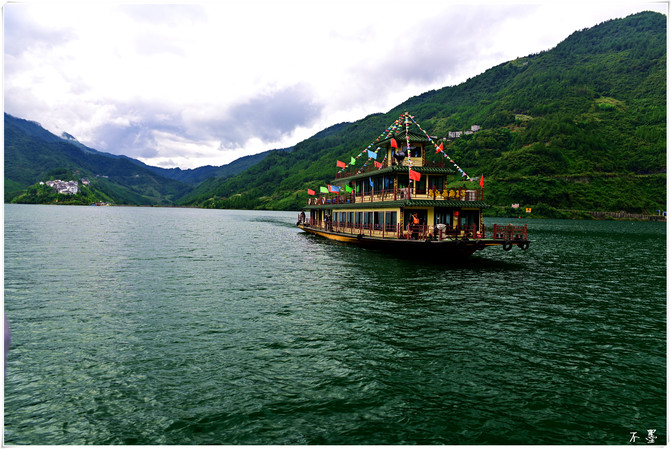
The Wanzu Wharf area is located at the confluence of the Wujiang River and the Ayi River, with a wide river surface. Boarding the cruise ship, the river breeze is gentle, the lake is shimmering, and the green mountains, clear waters, and Buddha's face come, making me feel like I'm in a painting.

The Wujiang Gallery is a section of the Wujiang River, which is actually a reservoir. Due to the construction of Pengshui Power Station, the entire water surface has been raised, making the power station have the functions of navigation, flood control, water storage, and power generation. It has now become a landscape of Wujiang Gallery.

The villages by the river face the river and are backed by mountains, like immortal dwellings.



The stern of the ship was splashed with waves, and the power station and village gradually drifted away. The cruise ship entered the canyon area.


The mountains on both sides of the strait change in shape, sometimes resembling mythical beasts, and sometimes the rock walls are majestic, with a myriad of wonders and changes in scenery.


The water in Wujiang Gallery is the most pleasing and refreshing. Pure and transparent, this color alone is intoxicating. At first, it is dark green, but when it reaches the mountain bay, it turns into emerald green. A silver ribbon hangs on the mountainside, and a small boat sways in the Yao Pool. The Wujiang Gallery is like this, with ink paintings spreading out one by one.
About an hour and a half later, the cruise ship turned back and returned to Wanzu Pier.
Gongtan Ancient Town
The Wujiang Gallery Visitor Center is about an hour's drive from Gongtan Ancient Town. At 4 pm, you will arrive at the Qianshan Inn in Gongtan Ancient Town. The inn is located at the entrance of the ancient town. It's still early, so pack your luggage and enter the ancient town. Perhaps due to the off-season, or perhaps after the peak tourist season, the ancient town is sparsely populated with visitors and no one charges admission fees.
Gongtan Ancient Town is located in Youyang County, Chongqing, at the confluence of the Wujiang River and the Apeng River. It is adjacent to Pengshui County in Chongqing and Yanhe County in Guizhou Province. Since ancient times, it has been a hub for the transfer and distribution of goods in the Wujiang River Basin, and is now a core attraction of the Wujiang Gallery. Due to the construction of the Wujiang Power Station, the real ancient town no longer exists. The Gongtan Ancient Town in front of us has been rebuilt in the same way as the original. Although it is a replica, it can be easily mistaken for a real one. It's not bad to take a stroll around.

There are two paths to enter the ancient town, the riverside sightseeing road along the river and the stone paved road inside the town. Standing on the high observation deck outside the town, one can see buildings leaning against the river and scattered on the hillside.



Entering the ancient town feels like a memory.




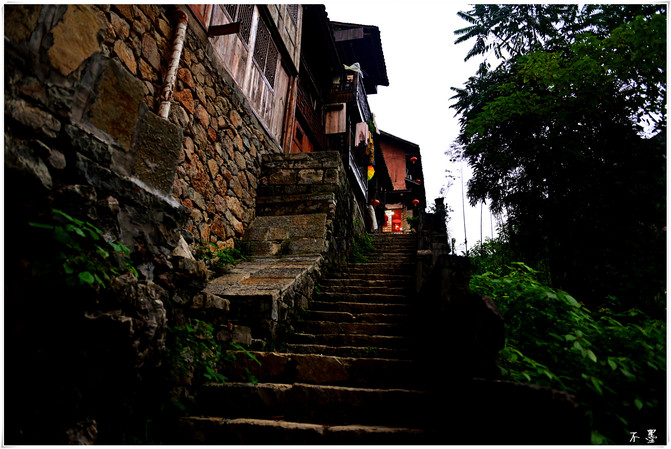
The green stone road, blooming triangular plum blossoms, and undulating small streets exude tranquility and comfort everywhere.




The shops facing the street, quiet courtyards, and mottled quotes from Chairman Mao on the wooden walls leave traces of time.



The mountain shadows are graceful, the river flows gently, and the residential buildings are scattered. Choose a tavern and sit by the railing, and you will already be drunk without drinking.
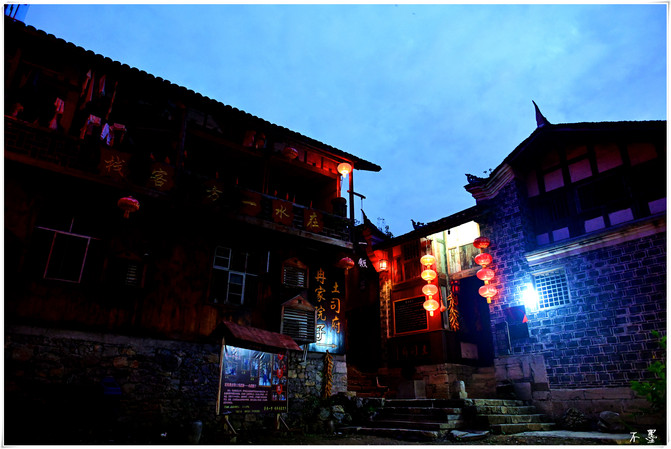
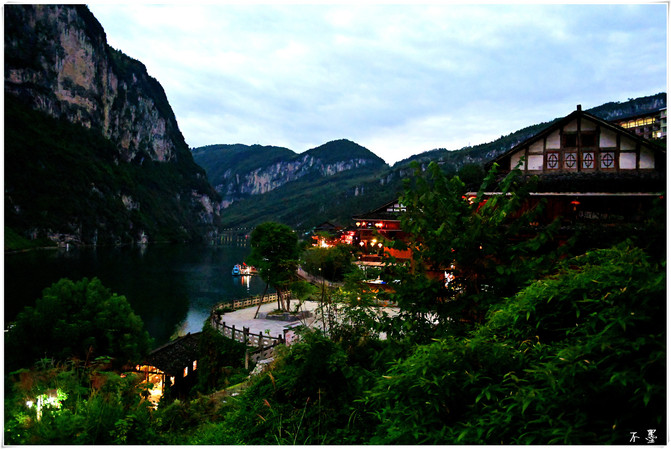

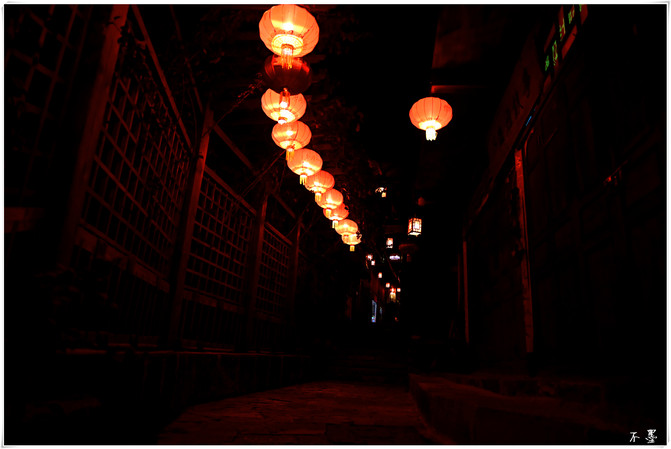

The sky gradually darkens, the lights dim, and the ancient town under the night sky appears even more enchanting and enchanting.





In the morning, the ancient town is shrouded in a layer of light mist, like a young girl wearing a thin veil, hazy, shy, and pure.
Apong River

Gongtan Ancient Town runs about 3 kilometers south along National Highway 211, and a clear stream flows from east to west into the Wujiang River, which is the Apeng River.


The Apeng River is quieter, thinner, and has purer water quality than the Wujiang River. The small boat sailed by, the water rippled, watching as it disappeared into the distance, unwilling to leave for a long time.
China Jinsi Nanmu Garden

The Chinese Golden Nanmu Garden was not included in the planned itinerary, but decided to take a look at it after seeing a sign that read "Chinese Golden Nanmu Garden" at the bridgehead of the Apengjiang Bridge. China Jinsi Nanmu Garden is located in Neikou Village, Liangzeng Township, Youyang County. It is easy to walk along the 211 National Highway from Apengjiang Bridge to Houjiawan and then turn left.
The Chinese Golden Nanmu Garden seems to be an undeveloped scenic spot, perhaps abandoned halfway. Anyway, the parking lot is large, and there are small buildings similar to resorts next to it. However, there are no staff members and almost no tourists, so there is no need to buy tickets. It is said that this village has hundreds of golden nanmu trees that are several hundred years old, among which eight are the most representative, and the two largest trees are over 600 years old.
These eight trees are distributed on the slope at the entrance of the village, namely the Door God Tree, the Couple Tree, the Top Scholar Tree, the Wealth Tree, the Peace Tree, the Son Sending Tree, the Baoye Tree, and the Longevity Tree.

The grapefruit that grew on the tree for the first time.


The door god tree is separated on both sides.

Christmas tree.

The husband and wife tree.

pachira macrocarpa.

The top scholar tree.
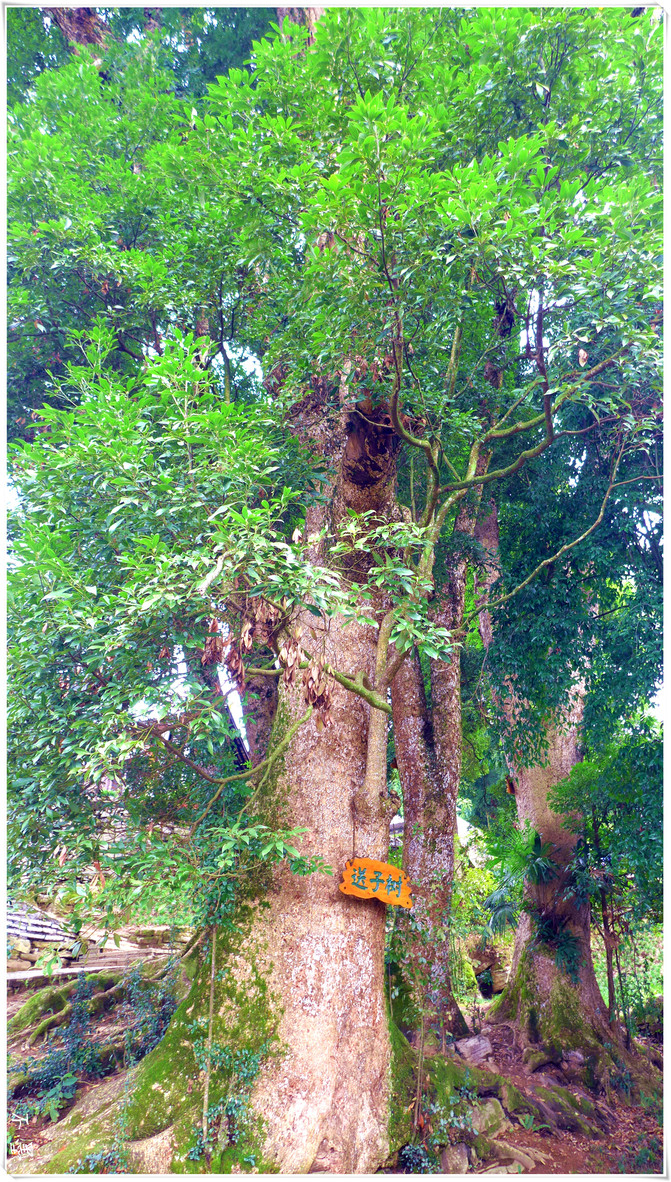
Sending off the child tree.



Baoye Tree.






Longevity tree, known as the king of Chinese golden nanmu, requires six people to surround its diameter. Its roots are thick and robust, and after more than 600 years, it has grown lush with branches and leaves, covering the sky and sun. The elderly people in the village come to this tree to worship and pray for a long life of a hundred years on their birthdays.
(End)
Previous Article:Chongqing is a great place to escape the summer heat on weekends, experiencing the unique charm of Qijiang for three days and two nights
Next Article:These buildings at the intersection of the two roads have left traces in modern Chinese history
